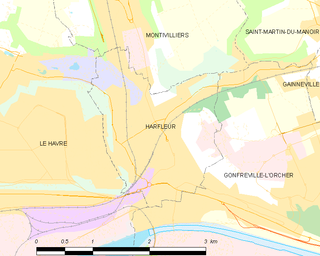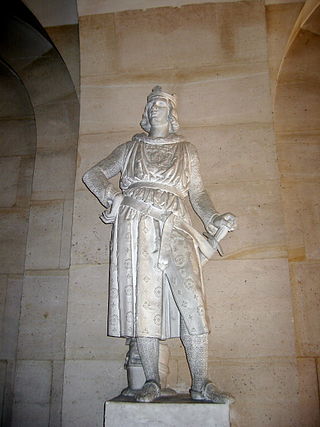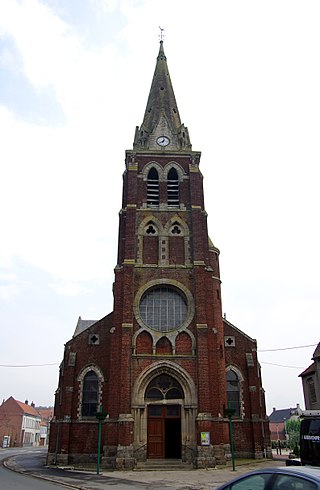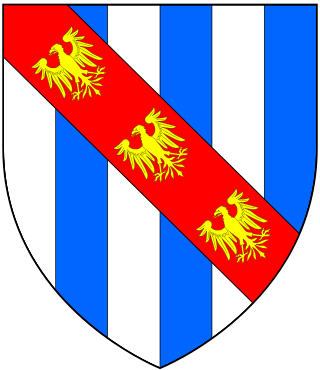Related Research Articles

The siege of Harfleur was conducted by the English army of King Henry V in Normandy, France, during the Hundred Years' War. The defenders of Harfleur surrendered to the English on terms and were treated as prisoners of war. It was the first time that an English army made significant use of gunpowder artillery in the siege of a large urban settlement.

The siege of Calais occurred at the conclusion of the Crécy campaign, when an English army under the command of King Edward III of England successfully besieged the French town of Calais during the Edwardian phase of the Hundred Years' War.

John I of Alençon, known as the Wise, was a French nobleman, killed at the Battle of Agincourt.

Robert III of Artois was a French nobleman of the House of Artois. He was the Lord of Conches-en-Ouche, of Domfront, and of Mehun-sur-Yèvre, and in 1309 he received as appanage the county of Beaumont-le-Roger in restitution for the County of Artois, which he claimed. He was also briefly Earl of Richmond in 1341 after the death of John III, Duke of Brittany.

Busnes is a commune in the Pas-de-Calais department in the Hauts-de-France region in northern France.

Preures is a commune in the Pas-de-Calais department in the Hauts-de-France region of France.
Jean I de Croÿ, Seigneur of Croÿ et d'Araines, Baron of Renty and of Seneghem, was the founder of the House of Croÿ.

The Battle of Calais took place in 1350 when an English force defeated an unsuspecting French army which was attempting to take the city. Despite a truce being in effect the French commander Geoffrey de Charny had planned to take the city by subterfuge, and bribed Amerigo of Pavia, an Italian officer of the city garrison, to open a gate for them. The English king, Edward III, became aware of the plot and personally led his household knights and the Calais garrison in a surprise counter-attack. The French were routed by this smaller force, with significant losses and all their leaders captured or killed.
Amery of Pavy or of Pavia was a 14th-century English knight, originally from Pavia in Lombardy, who was made captain of Calais by King Edward III of England in 1347. He made a secret deal with Sir Geoffrey de Charny, a French knight, to sell Calais for 20,000 écus. After discovering the plot, Edward summoned Amery to London and confronted him, ordering him to keep his bargain with Geoffrey and say nothing of the king's knowledge. As Geoffrey gathered an army to take control of the town in December of that year, Edward brought an army from England to counter the French. The English then prevailed in the failed siege of Calais on 31 December 1349, and Edward transferred governance of Calais to John de Beauchamp and abated the arms of Amery in 1350. In 1352, Amery was captured and tortured to death by Charny.
On 6 May of 1405, a French army under the command of Waleran III, Count of Ligny and Saint-Pol besieged the English castle at Mercq in Pas-de-Calais.

The Crécy campaign was a series of large-scale raids (chevauchées) conducted by the Kingdom of England throughout northern France in 1346 that devastated the French countryside on a wide front, culminating in the Battle of Crécy. The campaign was part of the Hundred Years' War.
Jean Harpedenne II was a French aristocrat, administrator and military officer. He was the seigneur of Belleville and a Marmouset at the court of King Charles VI.

The Black Prince's chevauchée, also known as the grande chevauchée, was a large-scale mounted raid carried out by an Anglo-Gascon force under the command of Edward, the Black Prince, between 5 October and 2 December 1355 as a part of the Hundred Years' War. John, Count of Armagnac, who commanded the local French forces, avoided battle, and there was little fighting during the campaign.

Sir Eustace de Ribemont was a French nobleman, who was the French standard-bearer in 1346.
Château de Calais was a 13th century castle constructed to defend the port of Calais, France. It was razed to the ground in 1558, after being recaptured from the English by the French and a citadel built on its ruins.
Sir Pépin de Wierre, Lord of Maison-Ponthieu, was a French nobleman.

Thomas de Grandison, 4th Baron Grandison, KG, was an English soldier and nobleman.
The siege of Guînes took place from May to July 1352 when a French army under Geoffrey de Charny unsuccessfully attempted to recapture the French castle at Guînes which had been seized by the English the previous January. The siege was part of the Hundred Years' War and took place during the uneasy and ill-kept truce of Calais.
The Treaty of Guînes was a draft settlement to end the Hundred Years' War, negotiated between England and France and signed at Guînes on 6 April 1354. The war had broken out in 1337 and was further aggravated in 1340 when the English king, Edward III, claimed the French throne. The war went badly for France: the French army was heavily defeated at the Battle of Crécy, and the French town of Calais was besieged and captured. With both sides exhausted, a truce was agreed that, despite being only fitfully observed, was repeatedly renewed.

English offensives in 1345–1347, during the Hundred Years' War, resulted in repeated defeats of the French, the loss or devastation of much French territory and the capture by the English of the port of Calais. The war had broken out in 1337 and flared up in 1340 when the king of England, Edward III, laid claim to the French crown and campaigned in northern France. There was then a lull in the major hostilities, although much small-scale fighting continued.
References
- Harari, Yuval Noah (2007). "For a Sack-full of Gold Écus: Calais 1350". In Harari, Yuval Noah (ed.). Special Operations in the Age of Chivalry, 1100–1550. Woodbridge, Suffolk, UK: Boydell Press. ISBN 978-1843832928.
- Piers, Hector Beaurepaire (1833). History of the town of Thérouanne, former capital of Morinie, and historical records on Fauquembergues and Renti. Lemaire.
- Sumption, Jonathan (1999). The Hundred Years War, Volume 1: Trial by Battle. University of Pennsylvania Press. ISBN 9780812216554.
- Sumption, Jonathan (2011). The Hundred Years War, Volume 2: Trial By Fire. Faber & Faber. ISBN 9780571266593.